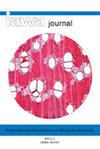针叶树核心的横截面:现存的南洋杉科和荚木科的木髓解剖,并与木髓化石的比较
IF 3.5
3区 农林科学
Q2 FORESTRY
引用次数: 0
摘要
木质物种中的坑起着重要的作用,从作为枝条中的第一个维管组织,到作为淀粉储存和促进心材形成。虽然髓的海绵细胞可能会死亡,并在成熟时被一些物种重新吸收,但髓在针叶树的整个寿命中都会持续存在。当代研究中记录了现存针叶树的髓特征和功能,并通过化石描述了已灭绝的前共生植物和针叶树祖先的髓解剖。然而,到目前为止,很少有研究描述活针叶树木髓的木材解剖,只涉及四个科的24个物种。在这里,我们根据染色和未染色的横截面,描述了以前未研究的南洋杉科和罗汉松科针叶树科的7属16种的髓。连续几年对同一棵树的髓节进行比较,可以深入了解针叶树髓的成熟情况。在属和科之间确定了保守的髓特征。南洋杉科的髓在家族层面上是不同的,但南洋杉属的髓形和异细胞性是统一的。相比之下,所有的罗汉果科木髓都有次生裂纹,大多数物种的木髓形状不规则。除了我们对南洋杉科和罗汉松科木髓的相似性和差异性进行研究外,研究古植物记录中的木髓模式以及活针叶树中的进一步例子,可以加深对木髓进化和保守特征的理解。本文章由计算机程序翻译,如有差异,请以英文原文为准。
Cross-sectioning to the core of conifers: pith anatomy of living Araucariaceae and Podocarpaceae, with comparisons to fossil pith
Pith in woody species fulfills essential roles, from functioning as the first vascular tissue in shoots, to serving as starch storage and facilitating heartwood formation. While the spongy cells of pith may die and be reabsorbed at maturity by some species, the pith persists throughout the lifespan of conifer trees. Pith features and functions of extant conifers have been documented in contemporary studies, and pith anatomy has been described for extinct progymnosperms and coniferous ancestors through fossils. However, up to now, few studies have described the wood anatomy of pith in living conifers and covered only 24 species in four families. Here we describe the pith of 7 genera and 16 species from the previously unstudied conifer families of Araucariaceae and Podocarpaceae, based on stained and unstained cross-sections. Comparisons between pith sections of the same tree in successive years yielded insights into maturation of the conifer pith. Conservative pith characteristics were identified among genera and families. Araucariaceae pith is dissimilar on a familial level, but the genus Araucaria is unified by pith shape and heterocellularity. In contrast, all Podocarpaceae piths develop secondary cracks, and most species have irregularly shaped piths. Beyond our study of similarities and differences of pith in Araucariaceae and Podocarpaceae, a look at pith patterns in the paleobotanical record and further examples in living conifers could increase the understanding of conserved characteristics and pith evolution.
求助全文
通过发布文献求助,成功后即可免费获取论文全文。
去求助
来源期刊

IAWA Journal
农林科学-林学
CiteScore
3.40
自引率
15.80%
发文量
26
审稿时长
>36 weeks
期刊介绍:
The IAWA Journal is the only international periodical fully devoted to structure, function, identification and utilisation of wood and bark in trees, shrubs, lianas, palms, bamboo and herbs. Many papers are of a multidisciplinary nature, linking
 求助内容:
求助内容: 应助结果提醒方式:
应助结果提醒方式:


